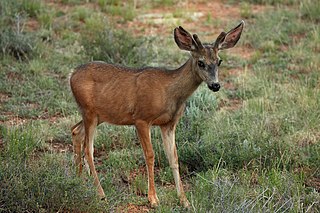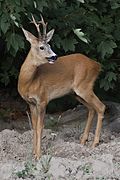
The roe deer, also known as the roe, western roe deer, or European roe, is a species of deer. The male of the species is sometimes referred to as a roebuck. The roe is a small deer, reddish and grey-brown, and well-adapted to cold environments. The species is widespread in Europe, from the Mediterranean to Scandinavia, from Scotland to the Caucasus, and east as far as northern Iran.

The eastern wolf also known as the timber wolf, Algonquin wolf or eastern timber wolf, is a canine of debated taxonomy native to the Great Lakes region and southeastern Canada. It is considered to be either a unique subspecies of gray wolf or red wolf or a separate species from both. Many studies have found the eastern wolf to be the product of ancient and recent genetic admixture between the gray wolf and the coyote, while other studies have found some or all populations of the eastern wolf, as well as coyotes, originally separated from a common ancestor with the wolf over 1 million years ago and that these populations of the eastern wolf may be the same species as or a closely related species to the red wolf of the Southeastern United States. Regardless of its status, it is regarded as unique and therefore worthy of conservation with Canada citing the population in eastern Canada as being the eastern wolf population subject to protection.

The Kazakh Steppe, also called the Great Dala, is a vast region of open grassland in Central Asia, covering areas in northern Kazakhstan and adjacent areas of Russia. It lies east of the Pontic–Caspian steppe and west of the Emin Valley steppe, with which it forms the central and western part of the Eurasian steppe. The Kazakh Steppe is an ecoregion of the temperate grasslands, savannas, and shrublands biome in the Palearctic realm. Before the mid-19th century, it was called the Kirghiz steppe, 'Kirghiz' being an old Russian word for the Kazakhs.

The Siberian roe deer, eastern roe deer, or Asian roe deer, is a species of roe deer found in northeastern Asia. In addition to Siberia and Mongolia, it is found in Kazakhstan, the Tian Shan Mountains of Kyrgyzstan, eastern Tibet, the Korean Peninsula, and northern China.

In paleoclimatology of the Holocene, the Boreal was the first of the Blytt–Sernander sequence of north European climatic phases that were originally based on the study of Danish peat bogs, named for Axel Blytt and Rutger Sernander, who first established the sequence. In peat bog sediments, the Boreal is also recognized by its characteristic pollen zone. It was preceded by the Younger Dryas, the last cold snap of the Pleistocene, and followed by the Atlantic, a warmer and moister period than our most recent climate. The Boreal, transitional between the two periods, varied a great deal, at times having within it climates like today's.

The European wildcat is a small wildcat species native to continental Europe, Scotland, Turkey and the Caucasus. It inhabits forests from the Iberian Peninsula, Italy, Central and Eastern Europe to the Caucasus. Its fur is brownish to grey with stripes on the forehead and on the sides and has a bushy tail with a black tip. It reaches a head-to-body length of up to 65 cm (26 in) with a 34.5 cm (13.6 in) long tail, and weighs up to 7.5 kg (17 lb).

Hybrid speciation is a form of speciation where hybridization between two different species leads to a new species, reproductively isolated from the parent species. Previously, reproductive isolation between two species and their parents was thought to be particularly difficult to achieve, and thus hybrid species were thought to be very rare. With DNA analysis becoming more accessible in the 1990s, hybrid speciation has been shown to be a somewhat common phenomenon, particularly in plants. In botanical nomenclature, a hybrid species is also called a nothospecies. Hybrid species are by their nature polyphyletic.

The Capreolinae, Odocoileinae, or the New World deer are a subfamily of deer. Alternatively, they are known as the telemetacarpal deer, due to their bone structure being different from the plesiometacarpal deer subfamily Cervinae. The telemetacarpal deer maintain their distal lateral metacarpals, while the plesiometacarpal deer maintain only their proximal lateral metacarpals. The Capreolinae are believed to have originated in the Middle Miocene, between 7.7 and 11.5 million years ago, in Central Asia.

The Altai wapiti, sometimes called the Altai elk, is a subspecies of Cervus canadensis found in the forest hills of southern Siberia, northwestern Mongolia, and northern Xinjiang province of China. It is different from the Tian Shan wapiti in being smaller and paler in color.

The Persian fallow deer is a deer species once native to all of the Middle East, but currently only living in Iran and Israel. It was reintroduced in Israel. It has been listed as endangered on the IUCN Red List since 2008. After a captive breeding program, the population has rebounded from only a handful of deer in the 1960s to over a thousand individuals.

Fauna of Wales includes marine and land animals, birds and reptiles that are resident, visitors or have been introduced to Wales.

Pleistocene Park is a nature reserve on the Kolyma River south of Chersky in the Sakha Republic, Russia, in northeastern Siberia, where an attempt is being made to re-create the northern subarctic steppe grassland ecosystem that flourished in the area during the last glacial period.

The eastern coyote is a wild North American canine hybrid with both coyote and wolf parentage. The hybridization likely first occurred in the Great Lakes region, as western coyotes moved east. It was first noticed during the early 1930s to the late 1940s, and likely originated in the aftermath of the extirpation of the gray wolf and eastern wolf in southeastern Ontario, Labrador and Quebec, thus allowing coyotes to colonize the former wolf ranges, and mix with the remnant wolf populations. This hybrid is smaller than the eastern wolf and holds smaller territories, but is larger and holds more extensive home ranges than the typical western coyote.
Wild Field is a 300 ha nature reserve near the city of Tula in Tula Oblast in the European part of Russia, approximately 250 km (150 mi) south of Moscow. It was established in 2012 by Russian scientists Sergey Zimov and Nikita Zimov as a companion to Pleistocene Park in Siberia.

The Khangai Mountains conifer forests ecoregion covers the northern slopes of the Khangai Mountains in central Mongolia. The montane taiga supports a populations of elk, deer, wild boar, wolves, and brown bear. The diversity of plants and animals has benefited from the relative isolation and low human population of the area.

The Central Korea deciduous forests is a temperate broadleaf and mixed forests ecoregion on the Korean Peninsula, covering portions of South Korea and North Korea.

The Alps conifer and mixed forests is a temperate broadleaf and mixed forests ecoregion in central Europe. It extends along the Alps mountains through portions of France, Italy, Switzerland, Germany, Liechtenstein, Austria, and Slovenia. The ecoregion extends from the lower slopes of the Alps to its peaks, which include Mont Blanc, at 4,809 m (15,778 ft) the highest peak in the Alps.



















